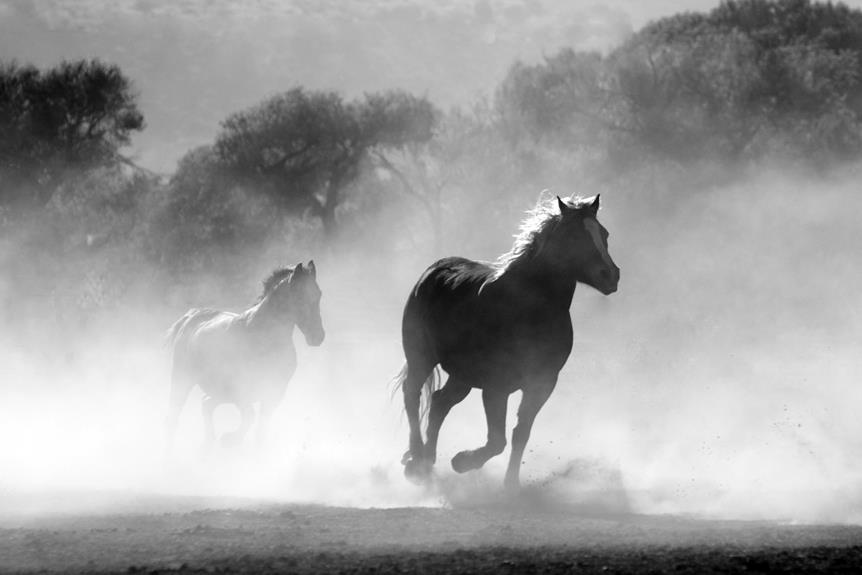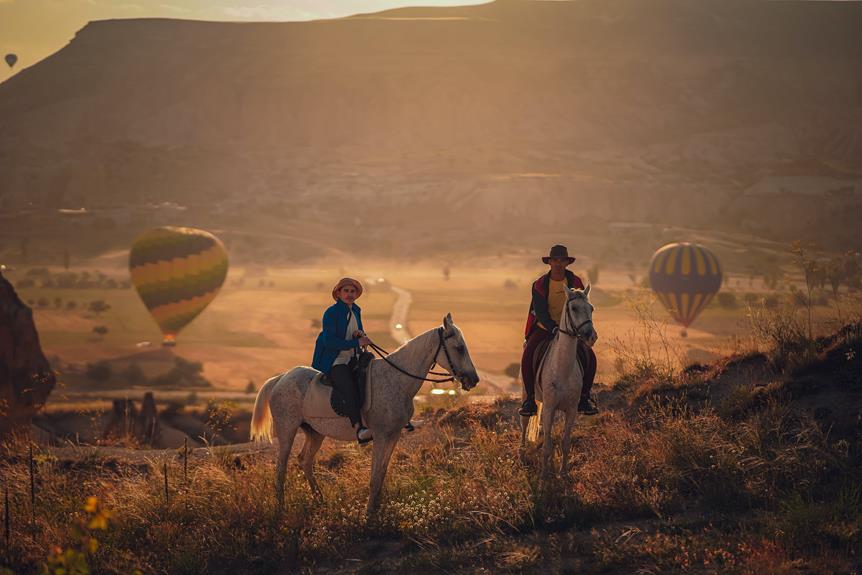Did you know that there are distinct differences between a mustang and a bronco horse? While both are known for their strength and agility, there are key characteristics that set them apart.
From their physical appearance to their temperament and roles, exploring the world of these iconic horses is sure to fascinate any equine enthusiast.
So, saddle up and prepare to discover the captivating contrasts and intriguing similarities between mustangs and broncos.
Key Takeaways
- Mustangs and Broncos differ in physical appearance and characteristics, with Mustangs being smaller and lighter, while Broncos are larger and more athletic-looking.
- Mustangs have a more sleek and agile build, reflecting their swiftness and agility, while Broncos have a rugged appearance due to their larger size and muscular build.
- Mustangs are known for their spirited nature and determination, making them ideal for various purposes, while Broncos are specifically bred for rodeo events.
- Mustangs can be tamed and trained relatively easily compared to Broncos, which may exhibit resistance to domestication and stubbornness during the training process.
Physical Appearance
When comparing the physical appearance of Mustangs and Broncos, there are distinct differences in size, build, and overall athletic appearance.
Mustangs, descended from the wild horses brought to the Americas by the Spanish, are smaller and lighter than Broncos. They typically measure 14 to 15 hands in height and weigh about 800 pounds.
In contrast, Broncos are larger and more athletic-looking, standing at around 16 hands high and weighing between 1200 and 1500 pounds. Mustangs have a sleek build, reflecting their swiftness and agility, while Broncos have a more rugged appearance due to their larger size and muscular build.
Mustangs, known for their speed, agility, and adaptability to various terrains, can run up to 35-45 miles per hour. On the other hand, Broncos exhibit a rough and untamed demeanor, showcasing raw power and athleticism.
While Mustangs can be any color found in horses and typically have brown eyes, Broncos can have rare horse colors and are typically larger and heavier due to their athleticism. Mustangs have strong hooves, making them adept at navigating difficult terrain, and they carry the strength, agility, and resilience of their Spanish ancestors.
In contrast, Broncos are specifically bred for rodeo events, unlike Mustangs which have a more subdued temperament. These physical differences in size, build, and overall athletic appearance between Mustangs and Broncos highlight their unique characteristics and suitability for specific populations and purposes in the western United States.
The Bureau of Land Management plays a crucial role in managing and preserving both Mustangs and Broncos, ensuring their continued existence and conservation.
Temperament
After exploring the physical differences between Mustangs and Broncos, let's now turn our attention to their contrasting temperaments.
Mustangs, as wild horses descended from Spanish breeds, have unpredictable personalities. Due to their natural development instead of selective breeding, each Mustang has its own unique temperament. However, with proper training, tamed Mustangs can develop a calm and gentle demeanor. They're known for their intelligence and curiosity, which makes them relatively easy to train compared to other horses.
On the other hand, Broncos have a wild and unpredictable temperament that has been specifically selected for rodeo events, based on their tendency to buck. Even when tamed, Broncos may exhibit resistance to domestication and stubbornness during the training process. Their spirited nature and determination make them ideal for rodeo events, but it requires an experienced rider to handle their strong-willed temperament.
Roles
One important aspect to consider when comparing Mustangs and Broncos is their respective roles.
Mustangs are wild horses that roam the western United States and are descendants of Spanish horses. They've a population that's managed by the government through roundups and adoptions. Once tamed, Mustangs can develop a calm and gentle temperament with proper training. They're versatile horses and can be used for various purposes, including pleasure riding and ranch work.
On the other hand, Broncos are a specific breed of horse primarily used in rodeo events, specifically in bronc riding. They've a wild and unpredictable temperament, selected for rodeo based on their tendency to buck. The use of tools such as spurs and bucking straps in rodeos raises ethical concerns for the welfare of Broncos.
Both Mustangs and Broncos are descendants of Spanish horses brought to the Americas, and they carry the influence of their Spanish ancestors, reflecting in their physical characteristics and behavior.
While Mustangs can be domesticated and have a wide range of roles, Broncos are specifically bred for their role in rodeo events, showcasing their wild and spirited nature.
Rodeo and Sport
Rodeo events prominently feature broncos, a specially bred horse known for their wild and unpredictable temperament, particularly in bronc riding competitions where riders aim to stay on their backs. Broncos are used in these events due to their size, strength, and athleticism, making them well-suited for the rough and challenging nature of rodeo sports. On the other hand, Mustangs, descendants of Spanish horses brought to the Americas, are not typically used in saddle bronc riding. Their smaller and sleeker build, along with their less aggressive temperament, makes them less suitable for the intense bucking and riding required in rodeo events.
To better understand the differences between Mustangs and broncos used in rodeo, let's take a look at the following table:
| Broncos | Mustangs | |
|---|---|---|
| Size | Larger and more muscular | Smaller and sleeker |
| Temperament | Wild and unpredictable | Less aggressive |
| Use | Primarily for rodeo events | Not typically used in rodeo events |
| Injury Risk | Can sustain injuries during competitions | Managed through roundups and adoptions, potential for stress and injury |
As you can see, there are clear distinctions between these two horse breeds. While Mustangs tend to be more reserved and are protected under the Wild Free-Roaming Horse and Burro Act of 1971, broncos are specifically bred and trained for the high-energy, adrenaline-filled world of rodeo. Conservation efforts and responsible management are essential to protect the population of wild horses like Mustangs while ensuring the welfare of broncos used in rodeo events.
Wild and Feral Horses
With a shift in focus, let's now explore the world of wild and feral horses, tracing their origins and understanding their significance in our natural heritage.
- Wild mustangs are a specific population of wild horses, descendants of Spanish horses brought to America centuries ago. These horses have adapted to living in the wild, carrying traits of their domesticated ancestors.
- Feral horses, on the other hand, are horses that have escaped or been released and now live in the wild without human intervention. They're untrained and have adapted to survive independently.
- The American West is home to many wild and feral horse populations, including mustangs. Over time, their population grew, and these horses have become an iconic symbol of the American frontier.
These wild and feral horses are an essential part of our natural heritage, representing the resilience and adaptability of these magnificent animals. Conservation efforts and responsible management are crucial to protect and preserve these populations, ensuring they continue to roam freely and contribute to the biodiversity of our ecosystems.
Understanding the distinction between wild mustangs and feral horses helps us appreciate the variety and diversity within the broader breed of horse and recognize their historical and ecological significance in the American West and beyond.
Frequently Asked Questions
What Is the Difference Between Mustangs and Wild Horses?
The difference between mustangs and wild horses is that mustangs are specifically a type of wild horse that roams freely in their habitat. They have their own unique behaviors, genetics, and herds. Mustang conservation involves managing their population through roundups, adoptions, and training.
What Is a Mustang Compared to a Horse?
A mustang is a breed of horse known for its exceptional speed, agility, and adaptability. They have a wild and untamed temperament but can be trained with proper techniques. Mustangs excel in competitions and have a significant historical significance. Conservation efforts aim to protect their population, habitat, and impact on the ecosystem. Adoption processes are in place to find suitable homes for these incredible animals.
What Classifies a Horse as a Bronco?
To classify a horse as a bronco, it is identified by its wild temperament and tendency to buck. Broncos are used in rodeo events and require specific training techniques and equipment for bronco riding competitions.
Are Mustangs Strong Horses?
Are Mustangs strong horses? Yes, Mustangs are known for their strength, endurance, and adaptability. Their breeding, genetics, and survival skills make them resilient. With proper training, they can become calm and gentle, showcasing their intelligence.
Conclusion
In conclusion, both mustangs and broncos offer unique qualities and abilities.
While mustangs can be more affordable and have a wilder nature, broncos are bred specifically for rodeo events and can be more expensive due to their specialized training.
Ultimately, it depends on your preferences and intended use for the horse.
Whether you choose a mustang or a bronco, both can be handled and trained by experienced riders.



0 Comments